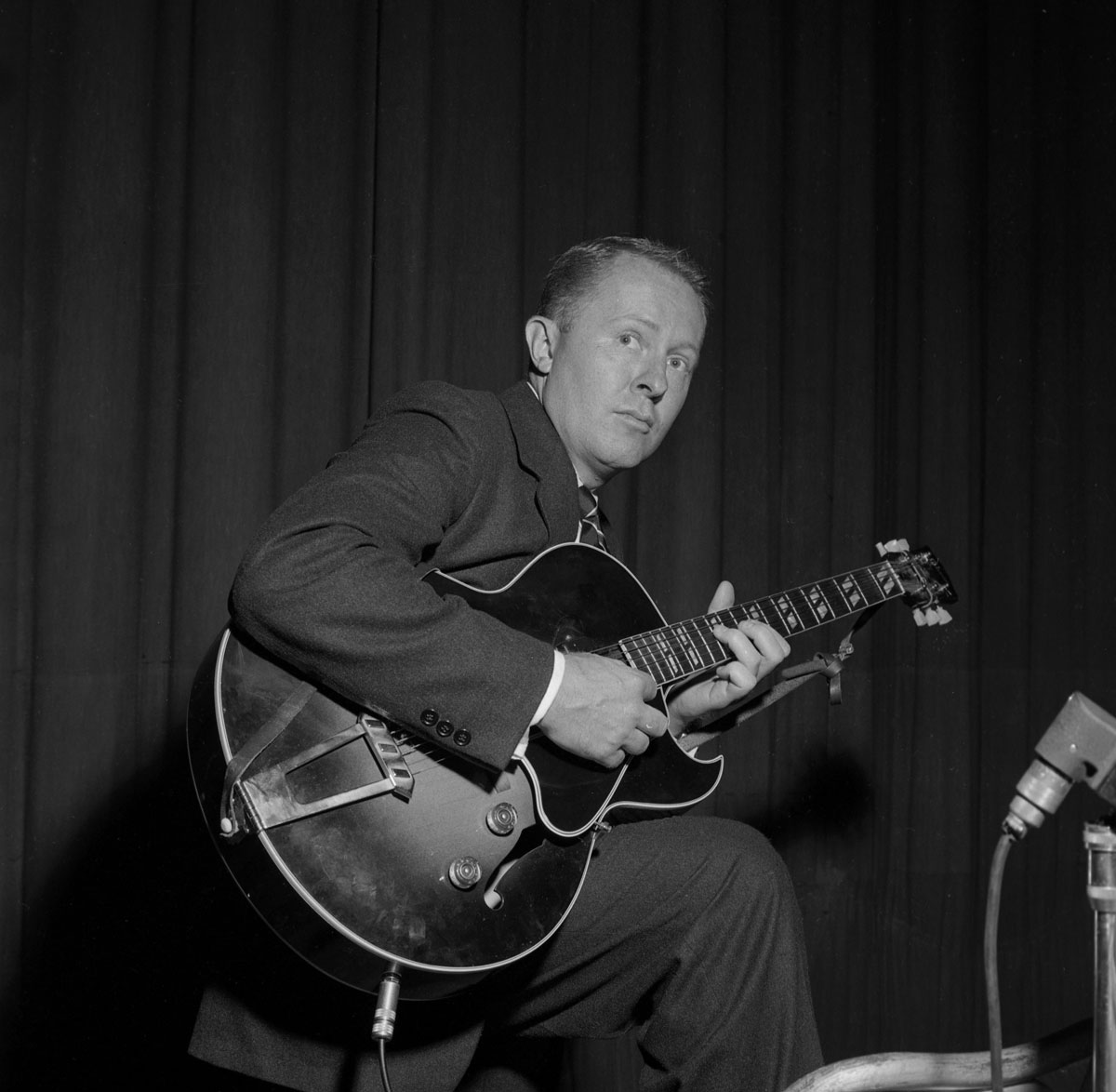How to solo melodically over jazz standards
Master soloing melodically over the ubiquitous II-V-I change for the key to unlocking your jazzy side

The major II-V-I is the backbone of jazz guitar as these chord changes occur in thousands of tunes and standards. Flick through the Real Book (the unofficial Bible of jazz standards) and stop on any page and you’ll almost certainly be faced with some II-V-I changes, be it Solar, Satin Doll, Autumn Leaves, All The Things You Are or Tune Up.
In this lesson we will look at five melodic methods for playing over this change, but first let’s clarify what a II-V-I is.
The Roman numerals I-II-III-IV-V-VI-VII refer to the chords in any particular Major key, so you can think ‘two chord’, ‘five chord’ and ‘one chord’. In a Major key, the II is Minor, the V is the Dominant chord and the I is Major.
To keep things simple, for this lesson all five examples are in C Major, so our II-V-I will be based around the Dm7-G7-Cmaj7 progression. The reason this is such a popular jazz progression is because those three chords have an inherent ‘tension and resolution’. We can spend a lifetime exploring ways of navigating and enhancing this cadence.

Since all three chords are in the same key (made up only from notes of C Major scale), you could theoretically play C Major across all of them and while this sounds absolutely fine, we can do a lot better. One way to play more melodically is to target the notes of each chord.
Our first example shows these ‘target’ notes, otherwise known as arpeggios. Example 1 shows the most simple way of practicing this. Start with a Dm7 arpeggio and play eighth notes for one bar, followed by a G7 for one bar and finally a Cmaj7 for 2 bars.
In each case we are making each chord change as smooth as possible by going to the nearest arpeggio note. Even though all of these notes are from the C Major scale, we can clearly hear the changes in the melody.
The next approach is ‘voice leading’. Listen to Example 2 and notice that the top note of each bar creates a descending chromatic melody, from E, to Eb, to D. This movement is very strong and leads the listener’s ear very logically through the progression.
The Roman numerals refer to the chords in each key, so you can think ‘two chord’, ‘five chord’ and ‘one chord'
Also in this lick we are using an ‘outside’ the scale note. The Db9 (tri-tone substitution for C major’s V7 chord, G7) added to the second bar adds tension to the progression.
Example 3 uses 3rd and 4th interval jumps to add some creativity to the melodies. Also we have three different scales: D Dorian (D-E-F-G-A-B-C), G Half-Whole (G-Ab-Bb-B-C#-D-D#-F) and C Lydian (C-D-E-F-G#-A-Bb). The Half-Whole scale is an excellent scale to bring out the altered tensions over the V7 (G13b9) chord.
Example 4 shows how you can use the Pentatonic scale shape to navigate the changes. Superimposing the A, Bb and B Minor Pentatonic over the II-V-I can yield some very hip results, using a very familiar shape.
Playing Am Pentatonic over the Dm7 gives us the intervals: R-5-b7-9-11. Bb Minor Pentatonic over the G7 chord gives us the intervals: b5-#5-b7-b9-#9, which is a very ‘outside’ sound. B Minor Pentatonic over C Major gives us: 3-#4-6-7-9, a Lydian flavor.
Our final example is more 16th-note, scale based and will help prepare your technique for when faster melodies are appropriate. This lick starts with regular C Ionian and C Major (C-D-E-F-G-A-B); then for the G7 chord we have the G Superlocrian scale (G-Ab-A#-B-Db- D#-F).
This is the 7th mode of the Ab Melodic Minor scale and has all of the cool alterations: b5, #5, b9 and #9 all wrapped around a Dominant 7 arpeggio.
Play through each example slowly and focus on playing cleanly and evenly.
Example 1

Start on the D root, then play the Dm7 arpeggio in eighth notes for one bar. Next start on B, which is the 3rd of our G root note, then descend the G7 arpeggio for xoloing Over IIm7-V7- I Major one bar. For the final two bars ascend and descend the Cmaj7 arpeggio, then start the loop again.
Example 2

Notice that the top note of each bar works as a descending, chromatic melody which we can call 'voice leading'. Once you have learnt these arpeggio fragments try creating your own licks by changing the note order, rhythm and phrasing to come up with a new 'tune'.
Example 3

Scales can sound quite stale if always played in a linear fashion, so here we have D Dorian, G Half-Whole and C Major played in 3rd and 4th interval jumps. Use finger rolls to move between notes on the same frets in order to only fret one note at a time.
Example 4

This lick uses the familiar minor Pentatonic in first position shape, starting on an A root, Then Bb, then B. So we can visualize this by moving the shape up one fret for each bar. This approach works really well using intervallic melodies, but blues licks may not work so well.
Example 5

This lick uses 16th notes through C Ionian and G Superlocrian modes. Alternate picking will give you the most even attack and note spacing, so start on a downstroke and keep your pick moving down and up throughout. Start slowly and build up the tempo once you are comfortable with the string changes.
Get The Pick Newsletter
All the latest guitar news, interviews, lessons, reviews, deals and more, direct to your inbox!
Charlie Griffiths plays guitar in acclaimed prog-metal outfit Haken, and has a wealth of experience handling corporate and session gigs for genres as diverse as rock, heavy metal and pop. He has been a regular contributor to Total Guitar, Guitar Techniques, and Guitar World for over a decade, and released his debut solo album Tiktaalika in 2022.
“There are so many sounds to be discovered when you get away from using a pick”: Jared James Nichols shows you how to add “snap, crackle and pop” to your playing with banjo rolls and string snaps
Don't let chord inversions bamboozle you. It's simply the case of shuffling the notes around








![Joe Bonamassa [left] wears a deep blue suit and polka-dotted shirt and plays his green refin Strat; the late Irish blues legend Rory Gallagher [right] screams and inflicts some punishment on his heavily worn number one Stratocaster.](https://cdn.mos.cms.futurecdn.net/cw28h7UBcTVfTLs7p7eiLe.jpg)


